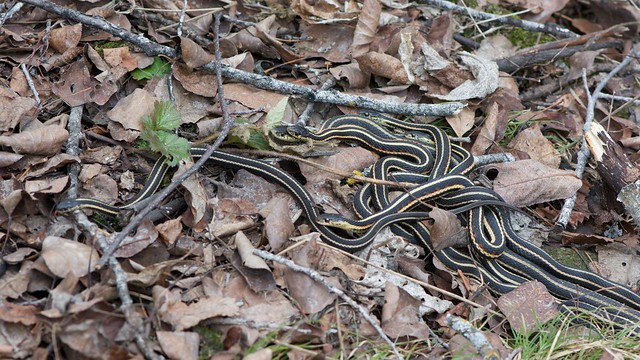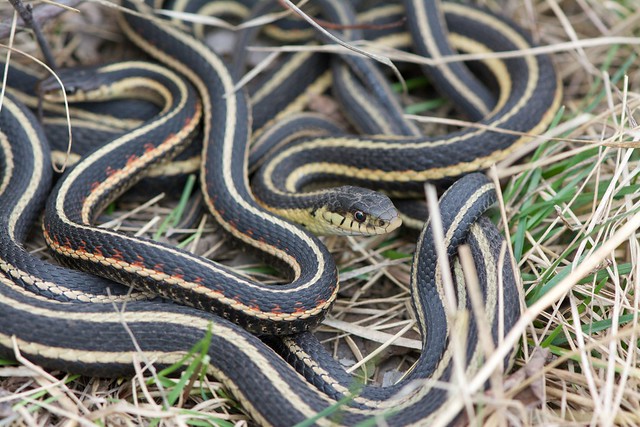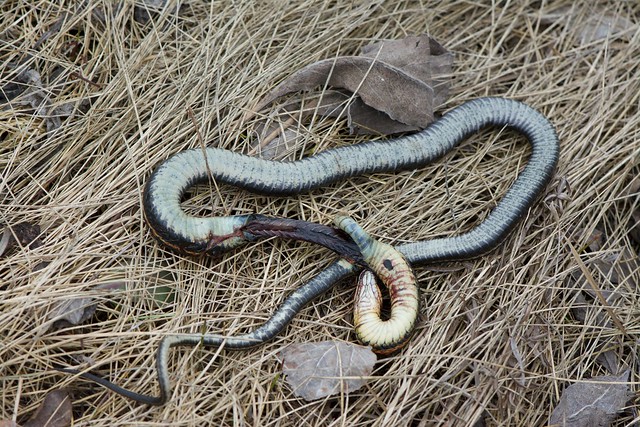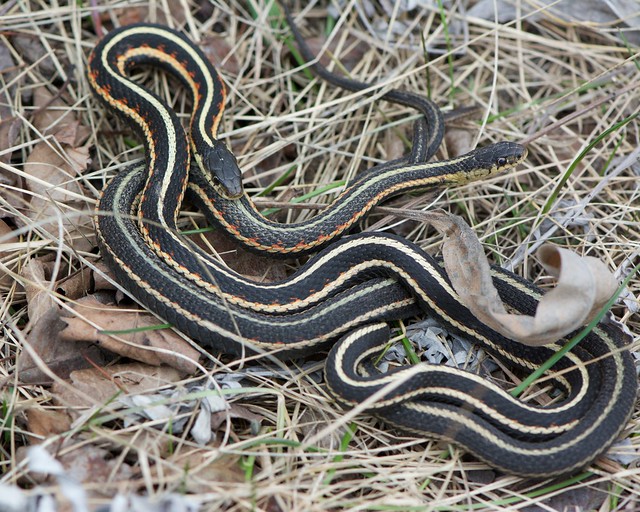A Visit to the Narcisse Snake Dens
I returned to the Narcisse Snake Dens for the first time in nearly eight years. What I saw there won’t surprise you. (Here’s a hint: snakes.)
On May 5, 2014, I visited the Narcisse Snake Dens. Located about a hundred kilometres north of Winnipeg, these dens are the hibernation site of tens of thousands of Red-sided Garter Snakes (Thamnophis sirtalis parietalis), the prairie subspecies of the Common Garter Snake. When they emerge each spring, they’re something of a tourist attraction, one that gets featured in the Canadian media. I don’t know how many government-supported tourist attractions there are in the world that are dedicated to snakes and snake conservation, but there can’t be many, and this is one of them.
For anyone interested in garter snakes, or even snakes in general, the Narcisse Snake Dens are a must-visit. Every spring, the garter snakes emerge ready to mate. A single mating ball — a large female surrounded by anything from several to dozens of male suitors — is impressive enough, but when thousands are out and about in the same location … well, you’ve never seen snakes so thick on the ground.
The dens are a function of geology and climate. Winters in Manitoba are bitterly cold, and snakes must get below the frost line to survive them. In northerly climates there generally aren’t that many places where snakes can get deep enough, so where there are such places, snakes tend to hibernate in large groups. The deep subterranean caverns at Narcisse, carved from limestone bedrock, are just the thing.
This was my fourth trip to the dens: I’d previously been there twice as a child, and once in August 2006. This time, though, I came closer to the peak spring season (though, it turned out, a little on the early side), and with some better camera equipment.
It’s a tourist attraction, but all things considered a minor (and seasonal) one, and the facilities reflect that. There are washrooms, picnic tables and interpretative signs; gravel walking trails take you between each of the four dens. It’s a long walk: expect to take at least a couple of hours. Don’t expect a cafeteria or a gift shop. Pack a drinking bottle. Narcisse itself is only a handful of houses six kilometres south of the dens. The nearest services are in the hamlets of Inwood (26 km) and Fraserwood (30 km); more services can be had in the larger towns of Gimli (47 km) or Teulon (49 km).
It was relatively cool when I arrived on the afternoon of the 5th: about 11°C (52°F), overcast, but not raining. There was one staff member on duty; she mentioned that there had been some activity earlier in the day, when it had been sunnier, but that the snakes were quieter now. Most of the activity was at Den 3, but snakes were emerging at Dens 1 and 2 as well. (Snake activity updates are posted online.) I think she was trying to manage our expectations, but she needn’t have worried. I’d never come at the exact peak of activity before, either, and it turned out that the snakes being a little less active made for better photography.
Before I go any further, a word about Red-sided Garter Snakes as they are found in Manitoba. Those of you who are familiar with this snake from the pet trade or from elsewhere in its range (it’s found from the Northwest Territories to Oklahoma, and from the Midwest to the Rockies) may find the Manitoba specimens to be, well, a little dark.
For so-called Red-sided Garter Snakes, there isn’t a whole lot of red to their sides, is there? Some individuals have more than others, but in some the red is mostly limited to the interstitial skin, if it’s there at all. Some individuals have black bellies, as well. Remember that we’re in a northerly and cold part of their range: darker skin is a beneficial adaptation that allows them to absorb heat better. (About a third of the Eastern Garter Snakes along the north shore of Lake Erie are melanistic, for the same reason.)
Common Garter Snakes have been able to tolerate astoundingly cold temperatures throughout their northern range: they are even among the few vertebrates able to tolerate freezing, like wood frogs, though only for a few hours or so. If nothing else, that means that the presence of a bit of snow at Den 3 didn’t daunt a couple of snakes.
So by those standards, 11°C wasn’t all that cold. But it wasn’t all that warm either. The snakes that had been active earlier in the day, when it was sunnier and they could bask, were a bit more quiescent. There wasn’t much activity in the pits themselves; they were either still underground or had already come out.
There were some snakes in the open field between Dens 2 and 3, hiding in the grasses. I’d noticed before that a garter snake’s stripes make good camouflage, especially in dead grass. Here and there I stumbled across a single snake taking cover in the grass.
They had reason to take cover. I also stumbled across a couple of dead garter snakes who had clearly been eviscerated, almost certainly by crows, who predate on garter snakes by tearing out just the liver, leaving the rest of the snake behind to die.
Near Den 3, though, there was a lot more shelter. Every nearby bush and shrub seemed to have a cluster or two of garter snakes. They seemed to be mating balls at rest: every female seemed to have up to three or four males cuddled up with her. The snakes tended to bolt if you got too close. In fact, disturbing them seemed to reactivate courtship behaviour: the female, running off, stimulated the males to follow her, rubbing their chins against her back to make her receptive to mating.
Most of the snakes I saw were quite small. If they had been well-fed captives, I’d say they were no older than in their second year. But these were wild snakes, whose feeding season is only a few months long: they’re not going to grow as quickly as captives who are fed frequently. They were probably older, particularly since neonate garter snakes don’t hibernate at the dens. At a minimum, this would have been the snakes’ second winter hibernation.
A lot of the females seemed small, too. I was expecting to see small males chasing after large females, and I saw lots of that:
But there were a few cases where the males seemed as big as, or bigger than, the female; you weren’t necessarily able to sex them on sight based on size.
Now it’s well-established that some males mimic female pheromones to lead other males astray, improving their own chances at females, but that’s not something I could test. I didn’t pick any snakes up.
If nothing else, the small size of many of the snakes does suggest that recruitment is healthy at the dens: young snakes are surviving long enough to be able to get frisky. (On the other hand, if you’d rather be pessimistic, maybe their small size is not so much because they’re young but because they’re starved.)
But that’s not to say that there weren’t any bigger snakes around. I encountered several large females, though they weren’t necessarily happy to have encountered me.
(That one didn’t have any males attached. Maybe they were afraid of her. Then again, I didn’t check for a copulatory plug to see if she’d already mated. But then I was a little afraid of her.)
The snakes at Narcisse were a little more aggressive than I remembered. As a child they seemed pretty tame to me, and I freehandled them with abandon; then again, it was even colder during my visits in 1980. When I moved to Ontario, I was surprised at what I now know to be standard wild garter snake belligerence. This time the Narcisse snakes were considerably jumpier: more easily startled, more likely to bolt at the approach of a big scary human, more likely to engage in threat displays.
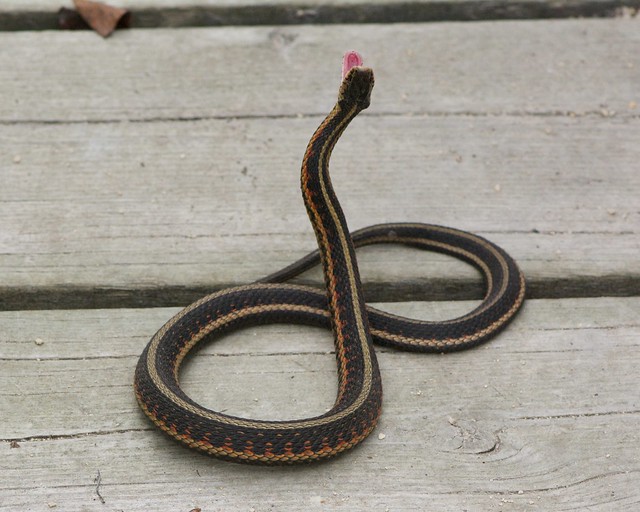
Or maybe I was just more fearless when I was eight.
I have even more photos of my visit. See them all on my Flickr album.
